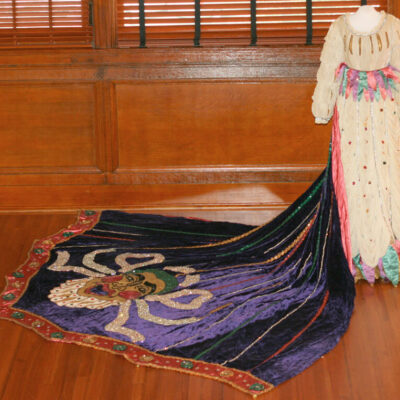Laissez les bons temps rouler! Let the good times roll! To celebrate Mardi Gras the Rosenberg Library displayed a vintage Mardi Gras Queen’s Costume as the February Treasure of the Month. Its owner, Margie Beth Spiller, was the “Queen of Galveston’s last Mardi Gras” in 1949 just before the celebration was ended for almost three decades. This irreplaceable piece of Galveston history was donated by Spiller’s husband, Dr. James Hejtmancik, in 1990. Also on display are newspaper clippings, invitations, and a program for the 1949 Mardi Gras courtesy of the Galveston and Texas History Center.

For those new to the island, Mardi Gras season is the roughly two weeks of celebrations that culminate on Fat Tuesday (Mardi Gras in French). This short period of revelry and excess (for some) is in preparation of the austere Lenten season which begins on Ash Wednesday. Some of the most entertaining traditions include parades with spectacular floats, marching bands, and catching beads / other ‘throws,’ exquisite balls, festive costumes, and eating rich foods like king’s cake.

Mardi Gras began on Galveston Island in 1867 and featured lavish masquerade balls, theatrical performances, and parades. The event quickly grew and attracted interest from across the region. In 1872 Governor Edmund Davis came to the island to attend the celebrations. Official festivities ceased during World War II, but organizations like the Artillery club, continued to host private events. In 1949 the City reinstated Mardi Gras, but participation during this period was sporadic and pricy, so it was again shut down in the mid-1950s. In 1982 local krewes started to organize small events. By 1985, with the support of George and Cynthia Mitchell, Larry Del Papa and other local business leaders, Galveston kicked off its modern Mardi Gras celebration which continues today.

1949 was a significant year for Mardi Gras in Galveston. It was the first time it had been celebrated since 1941 and would be one of the last major seasons until the 1980s. The Galveston Daily News from February 25, 1949 declared that, “It’s Mardi Gras Time — When Galveston Exemplifies the Real Spirit of Freedom” and ran proclamations from both Governor Beauford Jester and Galveston Mayor Herbert Cartwright to ring in the season. Eleven international ‘beauties’ from Europe and Latin America came to the island for the celebration, and the front page was dominated by Mardi Gras news for most of the season. It culminated at the coronation of the royal court when Mr. Harry Black won the title of King Frivolous XXV and Miss Margie Beth Spiller was made his queen.

Traditionally the royal court was announced during Fat Tuesday celebrations. The Galveston Daily News from Wednesday, March 2, 1949 described the royal court breakfast at the original Pleasure Pier’s Marine Room as a grand event that featured flags from across the world and other lavish decorations. The festivities reached a fever pitch just before the arrival of the royal court when Joe Relechman and his orchestra played, clowns paraded, exotic flowers were brought in, and a ballet group danced.
The theme of the 1949 Knights of Momus coronation was a “Good Ship Carnival” and Miss Spiller’s dress fit in beautifully. The one-piece gown of white velveteen is trimmed with gold lamé, satin, rhinestones, sequins, and bells. It is designed with a scooped neckline, fitted bodice, and sleeves accented with gold lamé. Each puff in the sleeves is banded with a double row of rhinestones. The skirt is divided into eight draped panels, separated from each other by a double row of rhinestones and iridescent sequins. A band of gold lamé overlaid with satin petal scallops in rose, green, and purple finishes the skirt. Each petal has a small brass bell attached. The waist band is made of green, purple, and rose satin petals held together with rhinestones.

The train is 12 feet long and weighs over fifteen pounds! It is made of purple velveteen lined with rose satin and trimmed with lamé sequins and rhinestones. A ruff at the neck is made of satin petals edged in gold sequins, each finished with a small brass bell. Extending down the train from the ruff are alternating rows of rhinestones, green, red, and gold scalloped sequin bands. A large laughing face of the Mardi Gras Jester is perhaps the most noticeable aspect of the entire outfit. His face is of the gold lamé, ruff of white velveteen outlined with sequins, and dotted with jewels. Rhinestones sewn on red and green satin encircle his head. A border of satin banded in gold sequins and alternating gold and green sequined pinwheels and brass bell finish the train.

